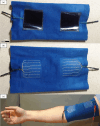A novel functional electrical stimulation sleeve based on textile-embedded dry electrodes
- PMID: 38835079
- PMCID: PMC11149225
- DOI: 10.1186/s12938-024-01246-8
A novel functional electrical stimulation sleeve based on textile-embedded dry electrodes
Abstract
Background: Functional electrical stimulation (FES) is a rehabilitation technique that enables functional improvements in patients with motor control impairments. This study presents an original design and prototyping method for a smart sleeve for FES applications. The article explains how to integrate a carbon-based dry electrode into a textile structure and ensure an electrical connection between the electrodes and the stimulator for effective delivery of the FES. It also describes the materials and the step-by-step manufacturing processes.
Results: The carbon-based dry electrode is integrated into the textile substrate by a thermal compression molding process on an embroidered conductive matrix. This matrix is composed of textile silver-plated conductive yarns and is linked to the stimulator. Besides ensuring the electrical connection, the matrix improves the fixation between the textile substrate and the electrode. The stimulation intensity, the perceived comfort and the muscle torque generated by the smart FES sleeve were compared to hydrogel electrodes. The results show a better average comfort and a higher average stimulation intensity with the smart FES sleeve, while there were no significant differences for the muscle torque generated.
Conclusions: The integration of the proposed dry electrodes into a textile is a viable solution. The wearable FES system does not negatively impact the electrodes' performance, and tends to improve it. Additionally, the proposed prototyping method is applicable to an entire garment in order to target all muscles. Moreover, the process is feasible for industrial production and commercialization since all materials and processes used are already available on the market.
Keywords: Dry electrodes; Functional electrical stimulation; Rehabilitation; Sleeve; Smart textile.
© 2024. The Author(s).
Conflict of interest statement
M.R.P. is the director, shareholder, and co-founder of company MyndTec Inc. He is also consultant for company Fourier Intelligence.
Figures








References
-
- Burridge JH, Swain ID, Taylor PN. Functional electrical stimulation: a review of the literature published on common peroneal nerve stimulation for the correction of dropped foot. Rev Clin Gerontol. 1998;8:155–161. doi: 10.1017/S0959259898008260. - DOI
-
- Eraifej J, Clark W, France B, Desando S, Moore D. Effectiveness of upper limb functional electrical stimulation after stroke for the improvement of activities of daily living and motor function: a systematic review and meta-analysis. Syst Rev. 2017;6:40. doi: 10.1186/s13643-017-0435-5. - DOI - PMC - PubMed
MeSH terms
Substances
Grants and funding
LinkOut - more resources
Full Text Sources
Miscellaneous

